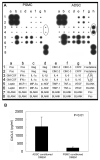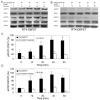Adipose tissue-derived stem cells secrete CXCL5 cytokine with neurotrophic effects on cavernous nerve regeneration
- PMID: 21114767
- PMCID: PMC3176296
- DOI: 10.1111/j.1743-6109.2010.02128.x
Adipose tissue-derived stem cells secrete CXCL5 cytokine with neurotrophic effects on cavernous nerve regeneration
Abstract
Introduction: Previously we reported that paracrine actions likely mediated the therapeutic effects of adipose tissue-derived stem cells (ADSCs) on a rat model of cavernous nerve (CN) injury.
Aim: To identify potential neurotrophic factors in ADSC's secretion, test the most promising one, and identify the molecular mechanism of its neurotrophic action.
Methods: Rat major pelvic ganglia (MPG) were cultured in conditioned media of ADSC and penile smooth muscle cells (PSMCs). Cytokine expression in these two media was probed with a cytokine antibody array. CXCL5 cytokine was quantified in these two media by enzyme-linked immunosorbent assay (ELISA). Activation of Janus Kinase/Signal Transducer and Activator of Transcription (JAK/STAT) by CXCL5 was tested in neuroblastoma cell lines BE(2)C and SH-SY5Y as well as in Schwann cell line RT4-D6P2T by Western blot. Involvement of CXCL5 and JAK/STAT in ADSC-conditioned medium's neurotrophic effects was confirmed with anti-CXCL5 antibody and JAK inhibitor AG490, respectively.
Main outcome measures: Neurotrophic effects of ADSC and PSMC-conditioned media were quantified by measuring neurite length in MPG cultures. Secretion of CXCL5 in these two media was quantified by ELISA. Activation of JAK/STAT by CXCL5 was quantified by densitometry on Western blots for STAT1 and STAT3 phosphorylation.
Results: MPG neurite length was significantly longer in ADSC than in PSMC-conditioned medium. CXCL5 was secreted eight times higher in ADSC than in PSMC-conditioned medium. Anti-CXCL5 antibody blocked the neurotrophic effects of ADSC-conditioned medium. CXCL5 activated JAK/STAT concentration-dependently from 0 to 50 ng/mL in RT4-D6P2T Schwann cells. At 50 ng/mL, CXCL5 activated JAK/STAT time-dependently, peaking at 45 minutes. AG490 blocked these activities as well as the neurotrophic effects of ADSC-conditioned medium.
Conclusions: CXCL5 was secreted by ADSC at a high level, promoted MPG neurite growth, and activated JAK/STAT in Schwann cells. CXCL5 may contribute to ADSC's therapeutic efficacy on CN injury-induced ED.
© 2010 International Society for Sexual Medicine.
Figures




References
-
- Celentano V, Fabbrocile G, Luglio G, Antonelli G, Tarquini R, Bucci L. Prospective study of sexual dysfunction in men with rectal cancer: feasibility and results of nerve sparing surgery. Int J Colorectal Dis - PubMed
-
- Hekal IA, El-Bahnasawy MS, Mosbah A, El-Assmy A, Shaaban A. Recoverability of erectile function in post-radical cystectomy patients: subjective and objective evaluations. Eur Urol. 2009;55:275–283. - PubMed
-
- Mulhall JP, Bella AJ, Briganti A, McCullough A, Brock G. Erectile function rehabilitation in the radical prostatectomy patient. J Sex Med. 2010;7:1687–1698. - PubMed
-
- Miles CL, Candy B, Jones L, Williams R, Tookman A, King M. Interventions for sexual dysfunction following treatments for cancer. Cochrane Database Syst Rev. 2007 CD005540. - PubMed
-
- Lin G, Chen KC, Hsieh PS, Yeh CH, Lue TF, Lin CS. Neurotrophic effects of vascular endothelial growth factor and neurotrophins on cultured major pelvic ganglia. BJU Int. 2003;92:631–635. - PubMed
Publication types
MeSH terms
Substances
Grants and funding
LinkOut - more resources
Full Text Sources
Other Literature Sources
Medical
Molecular Biology Databases
Research Materials
Miscellaneous

